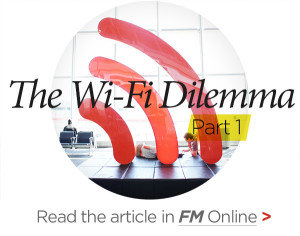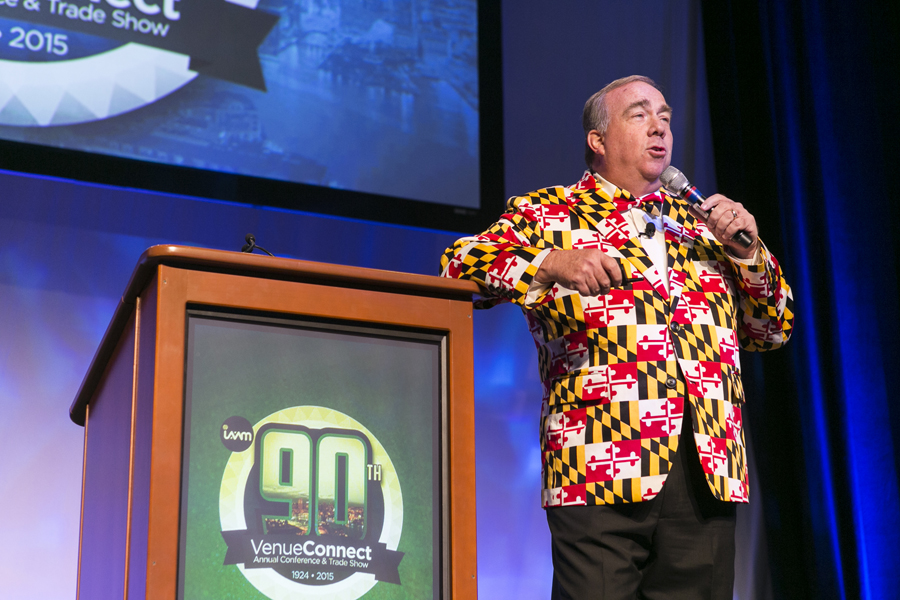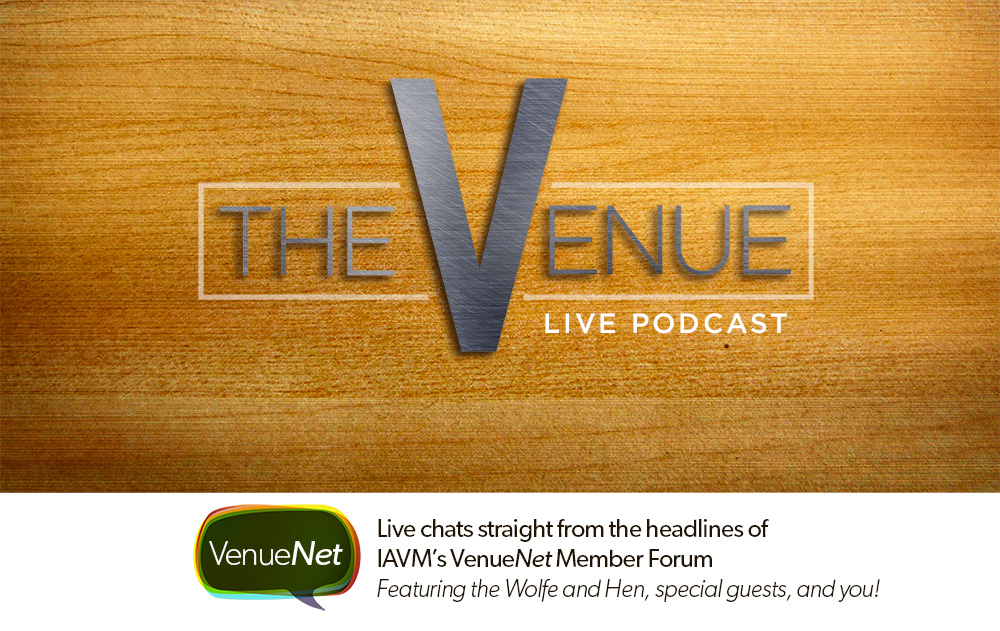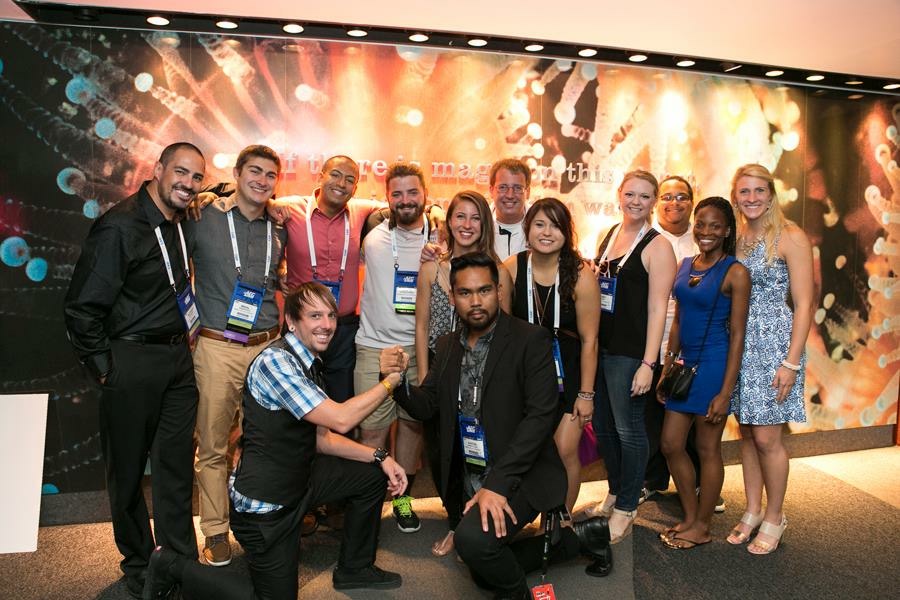Announcing the 2015 IAVM Venue Industry Award Winners
The 2015 Venue Industry Awards Luncheon—sponsored by Ungerboeck Software International and emceed by Chris Bigelow, founder and owner of The Bigelow Companies—took place during the 2015 VenueConnect Annual Conference & Trade Show in Baltimore, Maryland. The awards, hosted each year by IAVM, honor exceptional venues and professionals in several categories.
Join Us for a New Episode of The Venue
A new episode of our monthly podcast, The Venue, will air this Friday, August 28, at 2 p.m. (CST).
You can register at this link: https://attendee.gotowebinar.com/register/50090377894186342
 Our guest host will be Jeremy Huelsing, director of finance at Chaifetz Arena in St. Louis, Missouri, and a Young Professional Scholarship recipient for this year’s Arena Management Conference. We’ll discuss a variety of topics culled from VenueNet and beyond.
Our guest host will be Jeremy Huelsing, director of finance at Chaifetz Arena in St. Louis, Missouri, and a Young Professional Scholarship recipient for this year’s Arena Management Conference. We’ll discuss a variety of topics culled from VenueNet and beyond.
We hope you join us on Friday by calling in or listening!
VenueConnect Through the Eyes of Students
More than 30 students from all over the U.S. were in Baltimore, Maryland, for IAVM’s 90th VenueConnect. We asked them to share their experiences with us. Here are some responses.
“League of Legends” Championship Sells Out MSG
There was a sold-out event this past weekend at Madison Square Garden and it had nothing to do with music, hockey, or basketball. The event was the regional championship for the video game “League of Legends.”
“The dimly lit stadium was arranged around a stage featuring 10 chairs specially designed for gamers,” Sarah E. Needleman reported for the Wall Street Journal. “The historic arena began to look and sound more like a major league sports event as fans started pouring in, waving blue and red plastic batons and munching on popcorn and other snacks. Their cheers overpowered blaring music, as they shouted the names of their favorite teams and players.”
We’ve written a couple of posts (here and here) about the increasing popularity of eSports, and if you’re interested (and have 10 minutes to spare) to learn more about the phenomenon, watch the video below.
(Image: Business Insider Australia)
Smart City Networks Enters Into a Consent Decree With the FCC, Accepts Fine Related to Wi-Fi Management Technology Discontinued in 2014

In a statement released on August 18, 2015, the Federal Communications Commission’s (FCC) Enforcement Bureau announced a $750,000 settlement with Smart City Holdings, LLC, for “blocking consumers’ Wi-Fi at various convention centers around the United States.”
Smart City Networks has shared the following response on its web site:
“Smart City Networks (Smart City), the largest independent provider of managed network services to the convention and trade show industry, today announced it has entered into a Consent Decree with the Federal Communications Commission (FCC) that resolves an investigation related to the use of enabling technologies for managing and protecting Wi-Fi networks. As part of the Consent Decree, Smart City did not admit liability, and the FCC did not find that Smart City violated any laws.”
The following is a statement issued by Mark Haley, president of Smart City:
“Our goal has always been to provide world-class services to our customers, and our company takes regulatory compliance extremely seriously. We are not gatekeepers to the Internet. As recommended by the Department of Commerce and Department of Defense, we have occasionally used technologies made available by major equipment manufacturers to prevent wireless devices from significantly interfering with and disrupting the operations of neighboring exhibitors on our convention floors. This activity resulted in significantly less than one percent (1%) of all devices being deauthenticated and these same technologies are widely used by major convention centers across the globe as well as many federal agencies.
“We have always acted in good faith, and we had no prior notice that the FCC considered the use of this standardized, ‘available-out-of-the-box’ technology to be a violation of its rules. But when we were contacted by the FCC in October 2014, we ceased using the technology in question.
“While we have strong legal arguments, we’ve determined that mounting a vigorous defense would ultimately prove too costly and too great a distraction for our leadership team. As a result, we’ve chosen to work cooperatively with the FCC, and we are pleased to have resolved this matter. We are eager to return our energies to providing leadership to our industry and delivering world-class services to our clients.”
Managing high-density Wi-Fi environments is an issue that IAVM has been watching closely. After the FCC ruling against Marriott less than a year ago, IAVM’s Industry Affairs Committee responded with the formation of a Wi-Fi Coalition—currently tasked with providing resources and education that look at the issue of Wi-Fi management from all perspectives.
 As an extension of the coalition’s efforts, IAVM is publishing a series of articles in Facility Manager magazine that look closer at the realities of high-density Wi-Fi environments. “The Wi-Fi Dilemma, Part 1”, sets the stage by documenting the unprecedented surge in data usage that networks must try to keep pace with.
As an extension of the coalition’s efforts, IAVM is publishing a series of articles in Facility Manager magazine that look closer at the realities of high-density Wi-Fi environments. “The Wi-Fi Dilemma, Part 1”, sets the stage by documenting the unprecedented surge in data usage that networks must try to keep pace with.
As mentioned by event planner Brandt Krueger in 2014 after the Marriott fine, the “pollution” of a dense Wi-Fi environment is a very real problem for everyone paying for and expecting a high-performing network.
“Wi-Fi pollution is real, and the more hotspots that are jammed into an area, the more the integrity of the signals is degraded due to natural interference. When Marriott offers high speed Wi-Fi to their meeting and convention guests, usually for what some might call exorbitant rates, their guests are going to expect it to work properly. They do indeed have an obligation to provide certain levels of service to their guests, and they can’t offer that level of service if things are all jammed up with Wi-Fi traffic.”
The recent FCC rulings are eliminating tools used to ensure that a network can survive high-density situations. This, coupled with an absence of clarity on acceptable practices—or agreed upon standards that network managers can operate against—poses a seemingly impossible challenge to everyone tasked with operating large, functional Wi-Fi networks.
IAVM and the Wi-Fi Coalition will continue to focus on a potential way forward for network operators, trade show/event organizers, and venue managers, but the viability of building consensus and implementing improved procedures or policies will be determined largely by the decisions of the FCC.
Do you want to receive a Front Row News weekly digest?
Categories
- Allied (861)
- Architecture (147)
- Arenas (747)
- Career (897)
- Convention Centers (895)
- Education (623)
- Events (1,544)
- Food & Beverage (193)
- Foundation (113)
- Guest Experience (1,496)
- Industry News (2,270)
- Leadership (1,888)
- Marketing (150)
- Membership (2,000)
- Music (213)
- Performing Arts Centers (454)
- Professional Development (409)
- Research (127)
- Safety & Security (442)
- Sports (763)
- Stadiums (608)
- Student (159)
- Technology (516)
- Ticketing (92)
- Touring (82)
- Trends (364)
- Uncategorized (741)
- Universities (218)
- Video (25)
- Young Professional (198)
Twitter Feed
- Twitter feed loading
Recent Posts
- Peggy Daidakis Humbly Made Convention Center History
- Welcome to Our Newest Members
- New Member Benefit! IAVM Partners with Advantage Training to Elevate Staff Readiness and Guest Experience
- Charlotte Convention Center Welcomes Two New Leaders to its Management Team
- Fort Worth Cuts Ribbon on Phase 1 of Convention Center Expansion
Categories
- Allied
- Architecture
- Arenas
- Career
- Convention Centers
- Education
- Events
- Food & Beverage
- Foundation
- Guest Experience
- Industry News
- Leadership
- Marketing
- Membership
- Music
- Performing Arts Centers
- Professional Development
- Research
- Safety & Security
- Sports
- Stadiums
- Student
- Technology
- Ticketing
- Touring
- Trends
- Uncategorized
- Universities
- Video
- Young Professional
Archives
- December 2025
- November 2025
- October 2025
- September 2025
- August 2025
- July 2025
- June 2025
- May 2025
- April 2025
- March 2025
- February 2025
- January 2025
- December 2024
- November 2024
- October 2024
- September 2024
- August 2024
- July 2024
- June 2024
- May 2024
- April 2024
- March 2024
- February 2024
- January 2024
- December 2023
- November 2023
- October 2023
- September 2023
- August 2023
- July 2023
- June 2023
- May 2023
- April 2023
- March 2023
- February 2023
- January 2023
- December 2022
- November 2022
- October 2022
- September 2022
- August 2022
- July 2022
- June 2022
- May 2022
- April 2022
- March 2022
- February 2022
- January 2022
- December 2021
- November 2021
- October 2021
- September 2021
- August 2021
- July 2021
- June 2021
- May 2021
- April 2021
- March 2021
- February 2021
- January 2021
- December 2020
- November 2020
- October 2020
- September 2020
- August 2020
- July 2020
- June 2020
- May 2020
- April 2020
- March 2020
- February 2020
- January 2020
- December 2019
- November 2019
- October 2019
- September 2019
- August 2019
- July 2019
- June 2019
- May 2019
- April 2019
- March 2019
- February 2019
- January 2019
- December 2018
- November 2018
- October 2018
- September 2018
- August 2018
- July 2018
- June 2018
- May 2018
- April 2018
- March 2018
- February 2018
- January 2018
- December 2017
- November 2017
- October 2017
- September 2017
- August 2017
- July 2017
- June 2017
- May 2017
- April 2017
- March 2017
- February 2017
- January 2017
- December 2016
- November 2016
- October 2016
- September 2016
- August 2016
- July 2016
- June 2016
- May 2016
- April 2016
- March 2016
- February 2016
- January 2016
- December 2015
- November 2015
- October 2015
- September 2015
- August 2015
- July 2015
- June 2015
- May 2015
- April 2015
- March 2015
- February 2015
- January 2015
- December 2014
- November 2014
- October 2014
- September 2014
- August 2014
- July 2014
- June 2014
- May 2014
- April 2014
- March 2014
- February 2014
- January 2014
- December 2013
- November 2013
- October 2013
- September 2013
- August 2013
- July 2013
- June 2013
- May 2013
- April 2013
- March 2013
- February 2013
- January 2013
- May 2012
- March 2012
- December 2011
- November 2011
- October 2011
Recent Comments
- Frank Bradshaw, Ph.D., CVE on John Meyer, CVE, a Tireless Advocate of Certification for Venue Professionals, Has Died
- Neil Sulkes on Hilary Hartung, Friend to Many in Venue Marketing, Has Left Us
- Jason Parker, CVE on The Devastation of Hurricane Helene and How We Can Support One Another
- Larry Perkins on Touhey Testifies Against Speculative Ticketing Before Congressional Subcommittee
- Peter Secord on Major Players for Planned Elkhart Amphitheater Were in the Mix at VenueConnect




